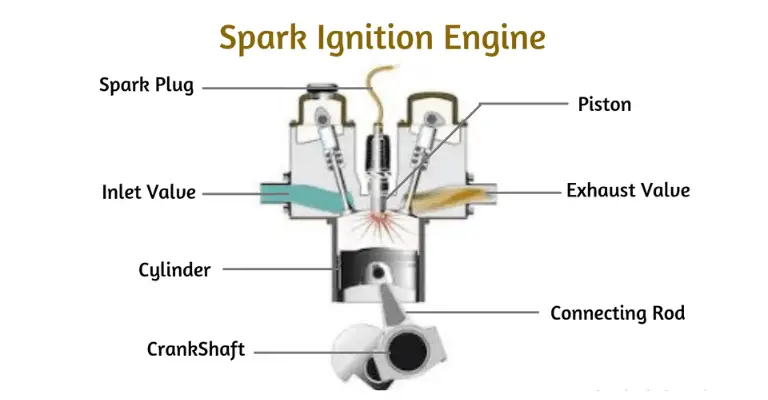A 50cc scooter that refuses to start, despite having a spark and fuel, can be quite a predicament. But before you panic, remember that with the right approach and a little elbow grease, you can get your scooter back on the road. Let’s dive into the details.
What Does a Scooter Need to Start?
To grasp the heart of the problem, we should first understand the three core elements a scooter needs to start:
- Fuel: Your scooter requires gasoline to power its engine.
- Spark: The spark plug ignites the fuel-air mixture in the engine cylinder.
- Compression: The scooter’s cylinder needs to compress the fuel-air mixture before it’s ignited.
If your scooter is missing any of these three elements, it won’t start. Here’s an infographic showing all these components (+air) work together:

What Keeps A Scooter from Starting then?
There are numerous reasons why a scooter may refuse to start, even if it appears to have spark and fuel:
- Battery Problems: If your scooter’s battery is dead or weak, it might not supply enough power to the ignition system.
- Ignition System Faults: If there’s a problem with your scooter’s ignition system (e.g., a faulty spark plug, ignition coil, or ignition switch), your scooter might not start.
- Fuel System Issues: These could range from an empty gas tank to a clogged fuel line or a malfunctioning carburetor.
- Compression Issues: If your engine isn’t properly compressing the fuel-air mixture (due to issues like worn piston rings or a blown head gasket), your scooter won’t start.
- Electrical Faults: Loose or broken wires, blown fuses, and faulty switches can all prevent your scooter from starting.
Here’s a video that goes further in depth about the three things a scooter needs to start, and continue running:
[su_youtube_advanced url=”https://www.youtube.com/watch?v=xW5y7a7CB1c”]
My Recommendations to Get Your Scooter Running
- Conduct a Thorough Inspection: Begin by visually inspecting your scooter for any obvious issues like loose or broken parts.
- Check the Battery: Ensure your battery is fully charged and the connections are secure.
- Inspect the Spark Plug: Remove the spark plug and look for any signs of damage or fouling.
- Check the Fuel System: Make sure there’s gas in the tank, the fuel line isn’t clogged, and the carburetor is clean and properly adjusted.
- Examine the Ignition System: Check the ignition switch, ignition coil, and other related parts for any signs of damage or wear.
- Perform a Compression Test: This can help you determine if there are any issues with the engine’s compression.
You may also need: Moped Won’t Start? Here’s What to Do
GY6 Common Problems Glossary
Check all of the Ignition, Fuel, and Intake Components
Let’s take a closer look at these components and what you should check.
Ignition Components
These include the battery, ignition switch, spark plug, and ignition coil. Check the battery for a full charge and secure connections. Inspect the spark plug for damage or fouling, and test the ignition coil with a multimeter.
Fuel Components
These include the fuel tank, fuel line, fuel filter, and carburetor. Ensure there’s gas in the tank and that the fuel line is clear. Check the fuel filter for blockages and inspect the carburetor for cleanliness and proper adjustment.
Intake Components
These include the air filter and intake manifold. Check the air filter to ensure it’s clean and unobstructed, and inspect the intake manifold for any signs of a leak.
What Causes These Components to Fail?
Several factors can contribute to the failure of these components:
- Neglect: Lack of regular maintenance can cause all sorts of problems, from a clogged fuel line to a fouled spark plug.
- Wear and Tear: Over time, parts can wear out and need to be replaced.
- Poor Quality Parts: Using cheap, low-quality parts can lead to premature failure.
- Improper Use: Misusing your scooter (like red-lining the engine or riding it on rough terrain) can damage various components.
Try to Kick or Jumpstart the Scooter
If your scooter still won’t start after checking all these components, you might try kickstarting it or jump-starting it with another battery. Just remember to always prioritize safety when doing this to avoid accidents or further damage to your scooter.
Related Questions
In the next section, we’ll tackle some frequently asked questions about scooter start-up issues.
Q1: Can a bad battery cause a scooter not to start, even if it has spark and fuel?
Yes, a bad battery can prevent a scooter from starting, even if it has spark and fuel. The battery provides the initial power needed to start the engine.
Q2: Can a faulty spark plug prevent a scooter from starting?
Absolutely. The spark plug is crucial to the ignition process. If it’s faulty or fouled, it won’t spark correctly and the engine won’t start.
Q3: How do I know if my scooter’s carburetor needs cleaning?
Signs that your scooter’s carburetor might need cleaning include difficulty starting, poor performance, and increased fuel consumption.
In conclusion, if your 50cc scooter won’t start but has spark and fuel, there might be an issue with one of its key components. By performing a thorough inspection and addressing any issues you find, you can get your scooter running again. Always remember, regular maintenance is the best way to prevent start-up problems and keep your scooter in top shape.